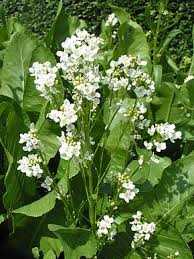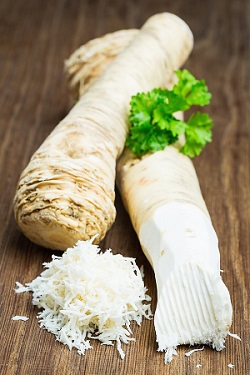
Shrimp and chickpea salad, cocktail sauce
Sliced ham and sundried tomatoes, goat cheese & cucumber
Beetroot tartare with herbs, horseradish cream

Hake, mixed vegetables, bouillabaisse sauce
Braised duck, roasted butternut, grape sauce extra 1.50 €
Revisited quiche with parsnip & Saint-Moret
Tajine of white beans with tomato & coriander, perfect eggs GLUTEN FREE Without Lactose

Poached pear with green tea & pomegranate
Panna Cotta with almond milk, fig coulis and Amaretti
Old-fashioned chocolate cream, mango marmalade, coconut rock
|

Having grown up in Alsace and seeing horseradish on our beautiful menu, my heart goes BOOM and my desire to tell you about it goes YES!
What is horseradish?
In the roots of this pretty white flower hides an unexpected burning flavor. Beware of its appearance, horseradish does not lack spice! The word comes from Old French "raiz" and "fort" and means "strong root". It is a herbaceous vegetable plant that belongs to the Brassicaceae family like cabbage, radish, turnip and wasabi.
Where is he from ?
Originally from Eastern Europe, horseradish is mentioned in the Old Testament Exodus, as part of the bitter herbs of the Jewish Passover.
Who consumes it?
As early as the XNUMXth century, it is present in Scandinavian and British kitchens - where it is still used in some sauces to accommodate the famous roast beef as horseradish. Jewish families include it in a beetroot-based preparation ... a bit like us this week! It is used in many countries of Central and Eastern Europe (especially in Germany and Poland), to spice up sauces and meats as well as in the United States in burgers.
What is eaten?
In the vegetable gardens, you can only see a plant with large leaves and small clusters of white or yellow flowers. But below, one cannot imagine a more unsightly root: resembling parsnip but larger and more crooked, with brown and rough skin, it measures up to 50 cm long, and 2 to 7 cm in diameter ... However, this is the edible part of the horseradish which, once peeled, has a beautiful creamy white color. It is most often used in the form of a condiment, incorporated in sauces, dressings or in a handled butter which can easily replace mustard. It is the ideal companion for cold meats, pot-au-feu or even sauerkraut cqfd it is the companion of my Alsatian youth!
Does it really sting?
Yes Yes ! It is not for nothing that it has been nicknamed "German mustard": it has a pungent and pungent flavor, as well as a penetrating odor, due to the natural presence of glucosinolates (organic compounds of self-defense against pests. ! ... it makes you cry even more than the onion by grating it). However, beyond strong sensations, horseradish reveals a marked vegetal freshness, which is not found in mustard. To soften its taste, it is very effective to dilute it with fresh cream. And unlike mustard, the spicy effect disappears between each bite.
Cousin of wasabi?
In the West, wasabi is nicknamed "Japanese horseradish". These two roots do not come from the same plant, but belong to the same Brassicaceae family. Oddly, wasabi is definitely more popular than its cousin horseradish, which has a bit of a dated connotation. Yet the majority of ready-made wasabi powders and pastes are made from horseradish, with wasabi root production insufficient to meet global demand.
What virtues?
In the past, it was known only for its healing benefits. Richer in vitamin C than orange, it was consumed by sailors to prevent scurvy. It is said to be depurative, antiseptic, antispasmodic, diuretic and stimulant. Just that !
 
|

